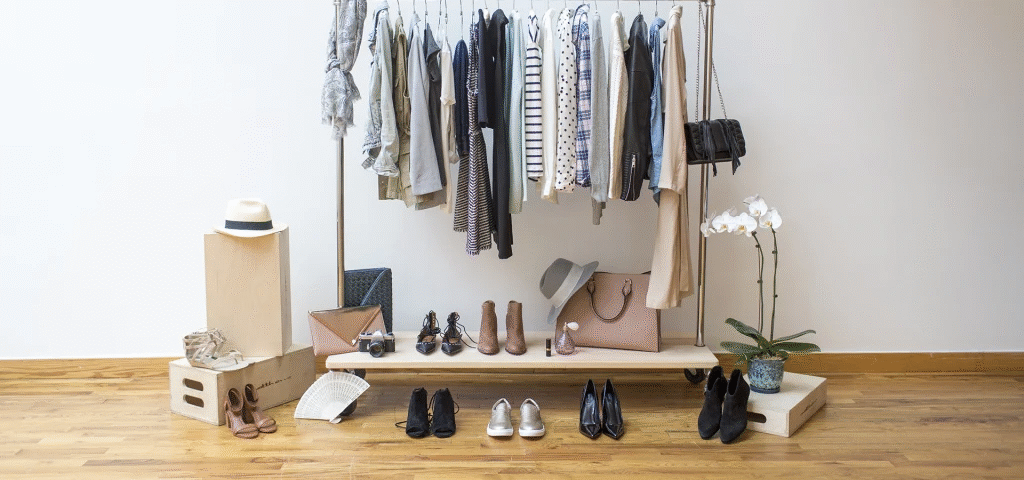
The Importance of Mental Health Awareness in Schools: Building a Supportive Future
September 4, 2025
Affordable Fashion Tips for College Students: Look Stylish Without Breaking the Bank
September 4, 2025Fashion is more than just the clothes we wear—it’s an expression of who we are. However, the modern fashion industry also has a huge environmental impact. Fast fashion contributes to pollution, waste, and unfair labor practices. That’s why more people are turning toward sustainable fashion. Building a sustainable fashion wardrobe doesn’t mean you have to sacrifice style or spend a fortune. Instead, it’s about making smarter choices that benefit you, the planet, and even the workers behind the clothes.
In this article, we’ll explore how to create a sustainable wardrobe step by step, explain what sustainability in fashion really means, and give practical tips that you can apply right away.
What Is a Sustainable Fashion Wardrobe?
A sustainable fashion wardrobe is built around clothes that are eco-friendly, ethically made, durable, and timeless. It prioritizes quality over quantity, focuses on long-term use, and minimizes harm to the environment.
Unlike fast fashion, where trends change every few weeks, sustainable fashion encourages mindful consumption. It’s not about having a closet full of clothes but about having fewer, versatile pieces that you truly love and wear often.
Why Does Sustainable Fashion Matter?
The fashion industry is one of the largest polluters in the world. According to studies, it contributes to greenhouse gas emissions, excessive water consumption, and mountains of textile waste. Fast fashion brands often use cheap synthetic materials, which release microplastics into oceans, and exploit low-wage workers in unsafe conditions.
Choosing sustainable fashion helps:
- Reduce waste by extending the life of clothes.
- Save resources like water and energy.
- Promote fair labor and ethical practices.
- Support local or small businesses that prioritize the environment.
By making small changes in how we buy and use clothes, we can make a big impact.
Steps to Build a Sustainable Fashion Wardrobe
1. Start with What You Already Own
The most sustainable clothing is the one already in your closet. Before buying anything new, go through your wardrobe. Ask yourself:
- Do I wear this often?
- Can it be repaired or restyled?
- Does it fit my current lifestyle?
You may discover forgotten pieces that can be styled in new ways. If something doesn’t fit or suit you anymore, donate, sell, or swap it instead of throwing it away.
2. Define Your Personal Style
Impulse buying often leads to clothes sitting unused. By identifying your personal style, you avoid unnecessary purchases. Think about:
- Colors you love and wear often.
- Fabrics that feel comfortable.
- Clothing shapes that suit your body type.
When you know your style, you can build a timeless wardrobe where everything works together, reducing the need for excess.
3. Choose Quality Over Quantity
Fast fashion items are cheap but wear out quickly. Instead, invest in quality clothing made from durable fabrics like organic cotton, linen, hemp, or wool. These materials not only last longer but also feel better on the skin.
Yes, sustainable pieces can cost more upfront, but since they last longer, you actually save money over time. For example, a well-made jacket may last 10 years, while a fast-fashion one might only last 1 or 2.
4. Shop from Sustainable Brands
Many ethical brands are committed to eco-friendly production, fair wages, and transparency. Look for certifications like:
- GOTS (Global Organic Textile Standard) for organic fabrics.
- Fair Trade Certified for ethical labor.
- OEKO-TEX for safe, chemical-free materials.
Supporting these brands encourages more companies to adopt sustainable practices.
5. Buy Second-Hand or Vintage
Thrift stores, consignment shops, and online resale platforms are treasure troves for sustainable fashion. Buying second-hand reduces demand for new production and gives clothes a second life. Plus, vintage pieces often have unique styles that make your wardrobe stand out.
6. Care for Your Clothes Properly
Extending the life of your clothing is one of the easiest ways to be sustainable. Simple habits like washing clothes in cold water, air-drying instead of machine drying, and storing them properly can keep them looking new for years.
Learning basic sewing skills, like fixing a button or repairing a seam, also prevents clothes from being discarded too early.
7. Embrace Capsule Wardrobes
A capsule wardrobe is a small collection of essential, versatile pieces that can be mixed and matched to create many outfits. For example, a white shirt, black trousers, a denim jacket, and a pair of sneakers can be styled in dozens of ways.
Capsule wardrobes not only reduce clutter but also save time when deciding what to wear.
8. Say No to Micro-Trends
Trends come and go quickly, especially in fast fashion. Instead of chasing them, focus on timeless, classic styles that never go out of fashion. A little black dress, a well-tailored blazer, or a pair of quality jeans will always be in style.
9. Swap and Borrow
Instead of buying something new for every occasion, try clothing swaps with friends or borrow outfits. Platforms for renting fashion are also gaining popularity, especially for formal events. This way, you enjoy variety without waste.
10. Recycle and Upcycle
If a piece of clothing can’t be worn anymore, don’t throw it in the trash. Many brands and local programs accept old clothes for recycling. Alternatively, upcycle them into something new—turn old jeans into shorts, or use fabric scraps for bags and home items.
Benefits of Building a Sustainable Wardrobe
- Financial savings: You buy less and save more in the long run.
- Stress-free dressing: With fewer but better pieces, getting dressed becomes easier.
- Better self-expression: Sustainable fashion encourages mindful choices that align with your values.
- Environmental impact: Less waste, less pollution, and more support for ethical practices.
Final Thoughts
Building a sustainable fashion wardrobe is a journey, not an overnight change. Start small—by wearing what you own, avoiding unnecessary purchases, and choosing better when you do buy. Over time, your wardrobe will become a reflection of not just your style but also your commitment to a healthier planet.
Fashion should make you feel good, not just look good. And when your choices help protect the environment and support fair labor, your style truly becomes timeless.
FAQs About Building a Sustainable Fashion Wardrobe
1. Is sustainable fashion always expensive?
Not necessarily. While some ethical brands charge more, you can also shop second-hand, swap clothes, or simply wear what you already own to save money.
2. How do I know if a brand is truly sustainable?
Check for certifications, transparency in sourcing, and details about fair labor practices. Brands that are vague or “greenwash” should be avoided.
3. Can I still follow fashion trends sustainably?
Yes, but choose trends that align with your style and can be worn long-term. Alternatively, explore second-hand options for trendy pieces.
4. What fabrics are best for sustainable fashion?
Organic cotton, hemp, linen, bamboo, and recycled fabrics are good options. They are eco-friendly and biodegradable.
5. How many clothes should a sustainable wardrobe have?
There’s no fixed number, but the idea is to have fewer, versatile, and high-quality pieces that you wear often rather than a closet full of unused clothes.




